自考国际商务英语课后题
- 格式:doc
- 大小:276.50 KB
- 文档页数:102
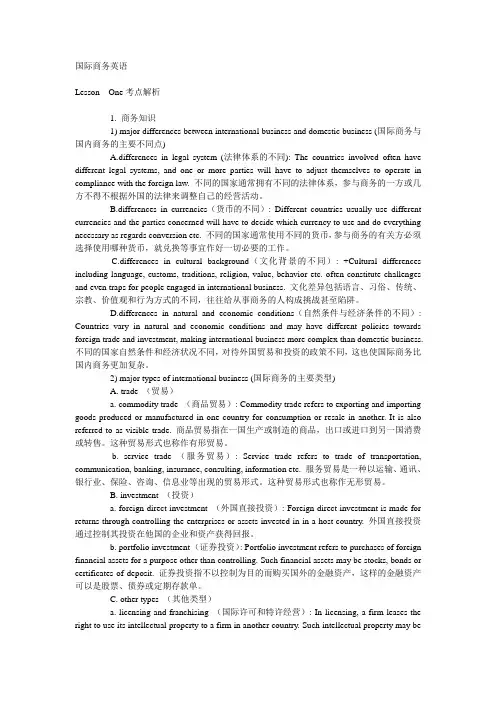
国际商务英语Lesson One考点解析1. 商务知识1) major differences between international business and domestic business (国际商务与国内商务的主要不同点)A.differences in legal system (法律体系的不同): The countries involved often have different legal systems, and one or more parties will have to adjust themselves to operate in compliance with the foreign law. 不同的国家通常拥有不同的法律体系,参与商务的一方或几方不得不根据外国的法律来调整自己的经营活动。
B.differences in currencies(货币的不同): Different countries usually use different currencies and the parties concerned will have to decide which currency to use and do everything necessary as regards conversion etc. 不同的国家通常使用不同的货币,参与商务的有关方必须选择使用哪种货币,就兑换等事宜作好一切必要的工作。
C.differences in cultural background(文化背景的不同): +Cultural differences including language, customs, traditions, religion, value, behavior etc. often constitute challenges and even traps for people engaged in international business. 文化差异包括语言、习俗、传统、宗教、价值观和行为方式的不同,往往给从事商务的人构成挑战甚至陷阱。
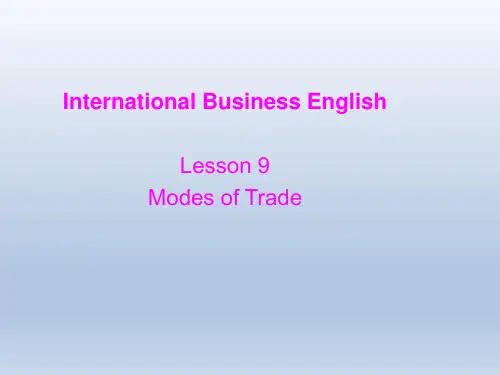
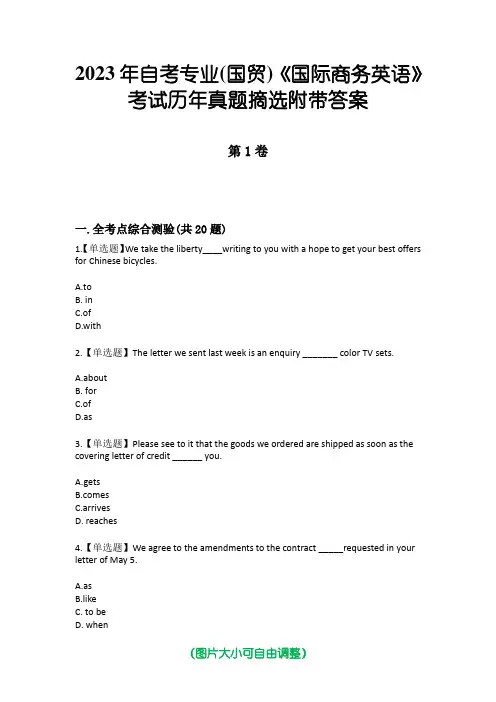
2023年自考专业(国贸)《国际商务英语》考试历年真题摘选附带答案第1卷一.全考点综合测验(共20题)1.【单选题】We take the liberty____writing to you with a hope to get your best offers for Chinese bicycles.A.toB. inC.ofD.with2.【单选题】The letter we sent last week is an enquiry _______ color TV sets.A.aboutB. forC.ofD.as3.【单选题】Please see to it that the goods we ordered are shipped as soon as the covering letter of credit ______ you.A.getsesC.arrivesD. reaches4.【单选题】We agree to the amendments to the contract _____requested in your letter of May5.A.asB.likeC. to beD. when5.【单选题】Our bank offers minimum interest ______ for seller financing and for loans of cash.A.levelsB.ratesC.basesD.percentage6.【单选题】We regret the need for you to write to us and hope the steps we are taking____the safe arrival of all your orders in the future.A.insureB. assureC.sureD.ensure7.【单选题】On receipt of your instruction, we shall carry out this order ______.A.in returnB.without least delayC.with least delayD.without delays8.【单选题】The importer will go to the wharf and____delivery of the goods.A.makeB.effectC.fulfillD.take9.【单选题】After unpacking the case we found the goods did not____with the original sample.pareB. matchC.agreeD.measure10.【单选题】____shipment, please amend the L/C to allow transshipment.A.RegardingB.CoveringC.ConcerningD. Referring11.【单选题】We cannot accept any fresh orders _______ heavy commitments.A.due toB.owing toC.becauseD.on account of12.【单选题】Because there is no direct steamer from here to your port, we suggest that you____trans-shipment at Hong Kong.A.may acceptB.acceptC.must acceptD. can accept13.【单选题】Many international companies produce a large number of products, often divided into product________.A.categoriesB.mixC.brandsD.lines14.【单选题】We would like to take this ______ to establish business relations with you.A.openingB.opportunityC. stepD.advantage15.【单选题】We have received your enquiry of October 15_____we learn that you are interested in our Sewing Machines.A.from whichB.in whichC. whichD.at which16.【单选题】______our catalogues for your reference.A.EnclosingB. Please find encloseC.Enclosed please findD.Enclosure17.【单选题】No discount will be allowed ____ you could place an order for more than 5,000pcs.A.untilB. exceptC.besidesD.unless18.【单选题】The credit of letter will be confirmed by the Bank of China, Shanghai, that will _______your draft on the documents at sight for the amount of your invoice.A. acceptB.pay forC. receiveD.obtain19.【单选题】To comply with your request, we are quoting you _____.A.as followingB.as followC. as followsD.follow20.【单选题】As we are ____ the market for Table cloth, we should be glad if you would send us your best quotation。
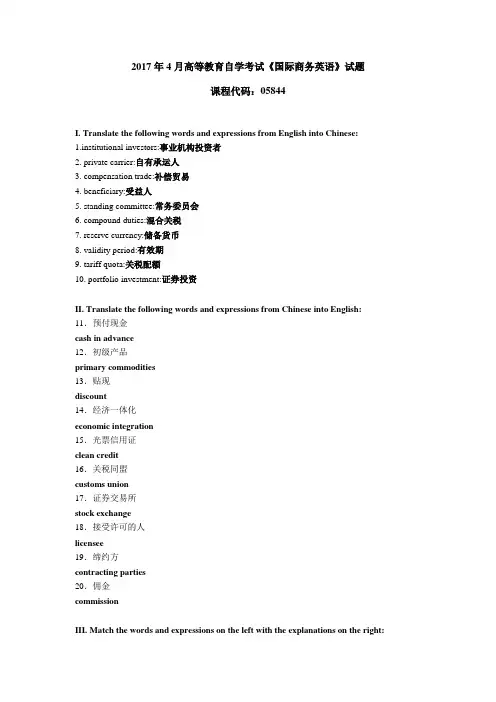
2017年4月高等教育自学考试《国际商务英语》试题课程代码:05844I. Translate the following words and expressions from English into Chinese:1.institutional investors:事业机构投资者2. private carrier:自有承运人3. compensation trade:补偿贸易4. beneficiary:受益人5. standing committee:常务委员会6. compound duties:混合关税7. reserve currency:储备货币8. validity period:有效期9. tariff quota:关税配额10. portfolio investment:证券投资II. Translate the following words and expressions from Chinese into English: 11.预付现金cash in advance12.初级产品primary commodities13.贴现discount14.经济一体化economic integration15.光票信用证clean credit16.关税同盟customs union17.证券交易所stock exchange18.接受许可的人licensee19.缔约方contracting parties20.佣金commissionIII. Match the words and expressions on the left with the explanations on the right:21. invoice a. a practical advantage given to one over others22. equities b. a place in which securities are sold and bought23. preference c. organization structure24. turnkey contract d. company stock25. insurance policy e. a document for the general description of the goods and the price26. market place f. one in which one of the parties agrees to supply, at the contract price, acomplete product ready for use, such as a new home, factory, ship, etc.27. force majeure g. argument or controversy28. framework h. a document used for covering possible risks29. dispute i. a person to whom one owns money30. creditors j. social or natural calamities that take place beyond the control ofacontracting party答:21. e 22. d 23. a 24. f 25. h26. b 27. j 28.c 29. g 30. iIV. Make brief explanations of the following terms or give the full name of the abbreviation in English:31. returnsThe gain from an investment, either as income or yield or as profit on the sale of the investment.32. world companyA multinational corporation whose national identity has been blurred.33. premiumThe amount of money paid by an insured for coverage under the contract.34. free trade areaMembers of a free trade area removes barriers to the flow of goods and services among themselves while each member still adopts its own policy as regards to trade with outsiders.35. MFNmost-favored-nationV. Answer the following questions in English :36. Can you give one example to illustrate "insurable interest"?Insurable interest holds that no one may insure anything unless he has an interest in it, which means that if the thing insured is preserved he will derive a benefit from its preservation, but if it is in any way damaged or lost the assured will be adversely affected.For example, you can insure your own car, for if it is damaged you will have to pay for it to be repaired and consequently you will suffer a loss.37. What is the difference between a sales contract and a purchase contract?When the contract is made by the seller, it is called a sales contract; and when made by the buyer, it is called a purchase contract.38. What are the nature and objectives of OPEC?OPEC refers to the Organization of Petroleum Exporting Countries and it is the most influential commodity cartel. By assigning production quotas among its members, OPEC tried to limit the overall crude oil supply of the world for the purpose of maintaining higher oil prices.39. Can you give at least five major types of credits?The major types of credits are given as follows: 1 ) clean credit and documentary credit; 2) revocable credit and irrevocable credit; 3 ) confirmed credit and unconfirmed credit; 4 ) sight credit and usance credit; 5 ) transferable credit and non-transferable credit; 6) non- draft credit; 7) revolving credit.VI. Translate the following into Chinese:40. The packing list gives information such as the number, date, name and description of the goods, shipping marks, packing, number of packages, specific contents of each package and its net weight and gross weight etc. Sometimes, the credit stipulates for specification list which is similar to the packing list but emphasizes the description of the specifications of the goods.装箱单所提供的是号码、日期、货物名称和说明、唛头、包装、件数,)每件的具体内容、净重和毛重等信息。
![国际商务英语简要和课后答案[1].docx](https://uimg.taocdn.com/8efd40f2a76e58fafab003f4.webp)
International Business EnglishLesson 1International BusinessBusiness Knowledge:The major differences between international business and domestic businessA.Differences in legal systemsB・ Differences in currenciesC.Differences in cultural backgroundD.Different in natural and economic conditionsThe major types of international businessA.Trademodity tradeb.Service tradeB.Investmenta.Foreign direct investmentb・ Portfolio investmentC.Other types3.Licensing and franchisingb.Management contract and contract manufacturingc.Turnkey project and BOTTrade Terms:1.Customs area 关税区:2.Conversion货币兑换3.Visible trade 有形贸易:The form of commodity trade, i.e. exporting andimporting goods produced or manufactured in one country for consumption orresale in another. (including cash transaction-by means of money and market, and counter trade)4.Invisible trade 无形贸易:The form of transportation, communication, banking,insurance, consulting, information etc. is called invisible trade or service industries.5.FD1 外国直接投资:Foreign direct investments. Returns through controlling theenterprises or assets invested in a host country. / P.256. One country acquires assets in a foreign country for the purpose of controlling and managing them.6.Portfolio investment 证券投资:Purchases of foreign financial assets for a purposeother than controlling.7.Stocks 股票:Capital stocks or bonds.& Bonds 债券:The papers issued by a government or a firm with promise to pay back the money lent or invested together with interest・9.Maturity (票据等)到期10.Certificate of deposit 人额存单11・Licensing 许可经营:In licensing, a firm leases the right to use its intellectual property to a firm in another country. They choose licensing because they do not have to make cash payments to stat business, and can simply receive income in the fonn of royalty・12.Franchising 特许经营:Under franchising, franchisee is allowed to operate in thename of another, franchiser who provides the former with trademarks, brand names, logos and operating techniques for royalty・13.Trade Mark 商标14.Patent 专利15.Royalty专利(许可)使用费,版税16.Copyright 版权17.Licenser 许可方1& Licensee被许可方19.Franchiser 特许方:A firm who provides the franchisee with trademarks, brandnames, logos and operating techniques for royalty・20.Franchisee 被特许方:A firm is allowed to operate in the name of anothe匚21.Management contract 管理合同:Under a management contract, one companyoffers managerial or other specialized services to another within a particular periodfor a flat payment or a percentage of the relevant business volume・22.Value chain 价值链23.Turnkey project"交钥匙”工程:For an international turnkey project, a firmsigns a contract with a foreign purchaser and undertakes all the designing,contracting and facility equipping before handing it over to the latter uponcompletion.)24. |B OT建设、经营和移交:Build, Operate, Transfer25.Expertise专门知识26.Bonus红利、奖金、津贴27.Royalty许可使用费28.International investment 国际投资:Supplying capital by residents of onecountry to another.29.Contract manufacturing 承包牛产3(). GATT 关贸总协定:General Agreement on Tariffs and Trade31.International business 国际商务:Transaction between parties from differentcountries. Sometimes business across the borders of different customs areas of the same country is also regarded as import and export・32.Intellectual property 知识产权33.Oil deposit:石油储备=oil reserves34.the reserves of natural resources 自然资源储备35.Personal advancement个人的晋升,个人素质的提高以及个人事业的进步等。
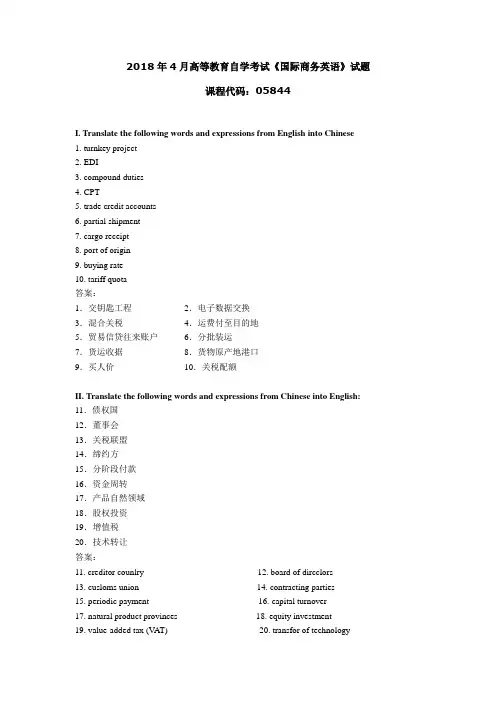
2018年4月高等教育自学考试《国际商务英语》试题课程代码:05844I. Translate the following words and expressions from English into Chinese1. turnkey project2. EDI3. compound duties4. CPT5. trade credit accounts6. partial shipment7. cargo receipt8. port of origin9. buying rate10. tariff quota答案:1.交钥匙工程2.电子数据交换3.混合关税4.运费付至目的地5.贸易信贷往来账户6.分批装运7.货运收据8.货物原产地港口9.买人价10.关税配额II. Translate the following words and expressions from Chinese into English: 11.债权国12.董事会13.关税联盟14.缔约方15.分阶段付款16.资金周转17.产品自然领域18.股权投资19.增值税20.技术转让答案:11. creditor counlry 12. board of dircclors13. cusloms union 14. contracting parties15. periodic payment 16. capital turnover17. natural product provinces 18. equity investment19. value-added tax (V AT) 20. transfor of technologyIII. Match the words and expressions on the left with the explanations on the right:21. spur a. unable to pay debts22. welfare b. ability to succeed in operation23. remittance c. to urge or encourage24. business line d. to repay or pay off25. drawee e. a person or thing that closely resembles another in position or function26. insolvent f. a person to whom a draft is drawn27. viability g. a person engaged in the practice of a profession or occupation28. redeem h. money sent by post29. practitioner i. goods dealt in by a company30. counterpart j. well-being答案:21. c 22. j 23. h 24. i 25. f26. a 27. b 28. d 29. g 30. cIV. Make brief explanations of the following terms or give the full name of the abbreviation in English:31. invoice32. credit-worthiness33. revenue34. exchange rate35. FCA答案:31. a document for the general description of the goods and the price32. being believed or accepted by olhers as rcliablc in making payments33. the total annual income of a state34. the price at which one currency can be exchanged for another currency35. Frcc CarricrV. Answer the following questions in English,.36. Explain briefly how a member borrows from the International Monetary Fund.37. What is a joint venture? How are the proportions of ownership determined?38. What are the differences between visible trade and invisible trade? Give a few examples ofinvisible trade.39.What are the nature and objectives of OPEC?答案:36. A member country is allowcd to bon'ow up to its gold tranchc contribution, now c,'-dlcd reserve tranchc contribution atttomatic,'-dly, and ,an additional 100 percent of its contribution in 4 steps, each with additionally stringent conditions established by tmf37. A joint venture is ,an independent business entity founded and owned by two or mom parlncrs called parents. (2 5})Thc proportions of owncrship between thc partners may bt: cquat or uncqual depending on their respective investments that al;: mostly in thc form of capital butt may also bc in land, equipment, or intellectual property.38.Visible trade involves thc import ,and export of goods, while invisible trade involves thc cxch,'mgc of services between coLmtdcs. Examples of invisible trade, include transportation service across national boLmdafics, insurance and tourism.39. OPEC (thc Organization of Petroleum Exporting Countrics) is thc most influcntial commodity cra'tel composed of thirLccn members established in 1960 with hcadquartcrs at Vienna. By assigning production quotas among its members, OPEC tried to limit thc ovcr,"dl crude oil supply of the world for thc purposc of maintaining higher oil prices.VI. Translate the following into Chinese:40. Sending goods from one country to another, as part of a commercial transaction, can be a risky business. If they are lost or damaged, or if delivery does not take place for some other reason,the climate of confidence between parties may degenerate to the point where a law suit isbrought.答案:40.作为商业交易的一部分,把货物从一国运至另一国可能是件冒风险的事。
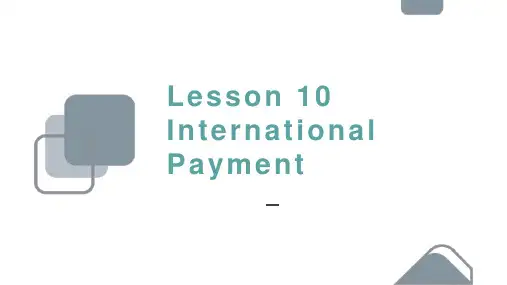
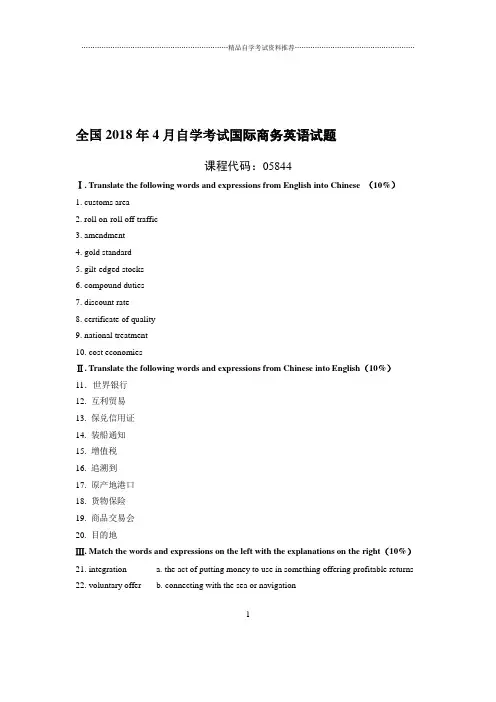
全国2018年4月自学考试国际商务英语试题课程代码:05844Ⅰ. Translate the following words and expressions from English into Chinese (10%)1. customs area2. roll on-roll off traffic3. amendment4. gold standard5. gilt-edged stocks6. compound duties7. discount rate8. certificate of quality9. national treatment10. cost economiesⅡ. Translate the following words and expressions from Chinese into English(10%)11.世界银行12. 互利贸易13. 保兑信用证14. 装船通知15. 增值税16. 追溯到17. 原产地港口18. 货物保险19. 商品交易会20. 目的地Ⅲ. Match the words and expressions on the left with the explanations on the right(10%)21. integration a. the act of putting money to use in something offering profitable returns22. voluntary offer b. connecting with the sea or navigation123. draft c. producing optimum results for the expenditure24. viability d. combining into a whole25. investment e. a person or an organization etc. that receives something26. export earnings f. the amount paid by an insured for coverage under the contract27. maritime g. an offer made on the initiative of the offerer28. premium h. money earned on the sale of goods to other countries29. cost-effective i. ability to succeed in operation30. recipient j. an unconditional order to someone to pay a sum of moneyⅣ. Make brief explanations of the following terms or give the full name of the abbreviation in English (10%)31. absolute advantage32. irrevocable credit33. indemnity34. green field strategy35. APECⅤ. Answer the following questions in English(20%)36. Why is it necessary to revise Incoterms in 1990?37. Why was the Special Drawing Right created?38. What contents should be included in a firm offer?39. What does international business refer to?Ⅵ. Translate the following into Chinese (15%)40. In insurance of all risks, the insurer is responsible for total or partial loss or damage to the insured goods arising from natural elements or from sea perils, including all losses caused by accidents to the carrying vessels or craft or by any external causes. But it does not, as its name suggests, really cover all risks.41. The term Triad refers to the three richest regions of the world, the United States, the European Union and Japan that offer the most important business opportunities. Any international enterprise must bear Triad in mind if they want to be successful in the increasingly competitive world market.Ⅶ. Translate the following into English(25%)242.在正常的市场交易中,由于使用货币及市场手段,货物的买与卖是分别进行的。
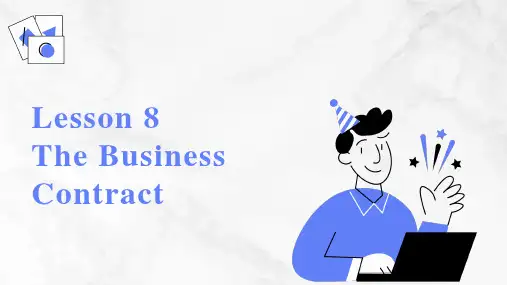
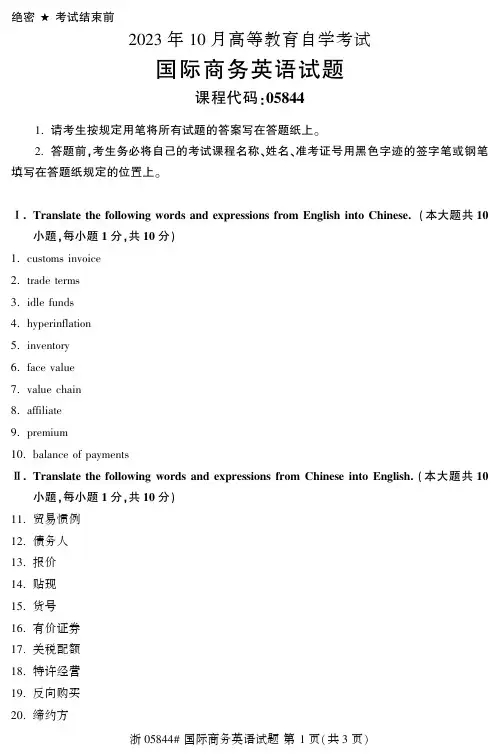
㊀㊀㊀㊀㊀㊀㊀㊀㊀㊀㊀㊀㊀㊀㊀㊀㊀㊀㊀㊀㊀㊀㊀㊀㊀㊀㊀㊀㊀绝密 考试结束前2023年10月高等教育自学考试国际商务英语试题课程代码:05844㊀㊀1.请考生按规定用笔将所有试题的答案写在答题纸上㊂㊀㊀2.答题前,考生务必将自己的考试课程名称㊁姓名㊁准考证号用黑色字迹的签字笔或钢笔填写在答题纸规定的位置上㊂Ⅰ.Translate the following words and expressions from English into Chinese.(本大题共10小题,每小题1分,共10分)1.customs invoice2.trade terms3.idle funds4.hyperinflation5.inventory6.face value7.value chain8.affiliate 9.premium 10.balance of payments Ⅱ.Translate the following words and expressions from Chinese into English.(本大题共10小题,每小题1分,共10分)11.贸易惯例12.债务人13.报价14.贴现15.货号16.有价证券17.关税配额18.特许经营19.反向购买20.缔约方浙05844#国际商务英语试题第1页(共3页)Ⅲ.Match the words and expressions on the left with the explanations on the right.(本大题共10小题,每小题1分,共10分)21.discrepancy22.turnkey contract23.integration24.liability25.revenuemercial intercourse27.remedy28.devaluation29.drawee30.drawer a.the act of a government in reducing by law the exchange value of its currency in units of gold or as compared with other currenciesb.method of putting right something that is wrong.c.the person who issues a draft,usually the exporterd.business dealings between individuals or firmse.one in which one of the parties agrees to supply,at the contract price,a complete product ready for use,such as a new home, factory,etc.bining into a wholeg.the total annual income of a stateh.what one is responsible for according to lawi.the person to whom a draft is drawnj.difference;absence of agreementⅣ.Make brief explanations of the following terms or give the full name of the abbreviation in English.(本大题共5小题,每小题2分,共10分)31.anti-dumping32.absolute advantage33.buyback34.documents against acceptance35.PPPⅤ.Answer the following questions in English.(本大题共4小题,每小题5分,共20分)36.How does WTO differ from GATT?37.What are the factors that have changed the transportation industry?38.What are the two types of business negotiations?39.Please describe briefly the characteristics of MNEs.Ⅵ.Translate the following into Chinese.(本大题共2小题,第40小题7分,第41小题8分,共15分)40.The bulk of international trade is done in the general mode of buying and selling of goods and services by means of money and the market.Under specific conditions,however,special modes of transactions may be adopted to better realize one s business purposes.浙05844#国际商务英语试题第2页(共3页)41. Letter of credit is often shortened as L/C,and is sometimes referred to as banker s credit , or commercial credit .Modern credits were introduced in the second half of the19th century and had great development after the First World War.The credit is a letter issued by a bank at the request of the importer in which the bank promises to pay upon presentation of the relevant documents.Ⅶ.Translate the following into English.(本大题共5小题,每小题5分,共25分)42.外汇汇率有三种形式,即:买进汇率㊁售出汇率和两者的平均值 中间汇率㊂43.国外直接投资主要有三种形式:建立新企业㊁购买现有设备和建立合资公司㊂44.国家从事的贸易种类是多样的㊁复杂的,往往是有形贸易和无形贸易的混合㊂45.许多人欢呼经济全球化带来的好处,但同时也有强烈的反对声音㊂46.如果信用证可以由原受益人转让给另一个或几个人,那么这种信用证即为可转让信用证㊂浙05844#国际商务英语试题第3页(共3页)绝密 启用前2023年10月高等教育自学考试全国统一命题考试国际商务英语试题答案及评分参考(课程代码㊀05844)Ⅰ.Translate the following words and expressions from English into Chinese.(本大题共10小题,每小题1分,共10分)1.海关发票2.贸易术语3.游资4.极度通货膨胀5.库存6.面值7.价值链8.分支机构9.保险费10.国际收支ʌ评分标准ɔ译文正确或基本正确得1分,否则不得分㊂Ⅱ.Translate the following words and expressions from Chinese into English.(本大题共10小题,每小题1分,共10分)11.trading practices12.debtor13.quotation14.discount15.article number16.securities17.tariff quota18.franchising19.counter purchase20.contracting partyʌ评分标准ɔ译文正确或基本正确得1分,否则不得分㊂Ⅲ.Match the words and expressions on the left with the explanations on the right.(本大题共10小题,每小题1分,共10分)21.j22.e23.f24.h25.g26.d27.b28.a29.i30.cʌ评分标准ɔ信息匹配正确得1分,否则不得分㊂国际商务英语试题答案及评分参考第1页(共3页)Ⅳ.Make brief explanations of the following terms or give the full name of the abbreviation in English.(本大题共5小题,每小题2分,共10分)31.anti-dumping:One form of action which may be taken by a government to protect industriesfrom unfair competition(1分)by which goods are sold at a price lower than in the country where they are manufactured.(1分)32.absolute advantage:The theory of absolute advantage holds that a commodity will beproduced(1分)in the country where it costs least in terms of resources.(1分) 33.buyback:An agreement by an exporter of plant and equipment(1分)to take back in thefuture part of the output produced by these goods as full or partial payment.(1分) 34.documents against acceptance:Documents are handed over to the importer upon hisacceptance of the bill of exchange drawn by the exporter.(1分)Payment will not be made until a later date.(1分)35.PPP:purchasing power parity(2分)ʌ评分标准ɔ(1)释义正确且无语言错误者得2分㊂(2)释义基本正确,但有一些语言错误者得1分㊂(3)释义错误或不答题者不得分㊂Ⅴ.Answer the following questions in English.(本大题共4小题,每小题5分,共20分) 36.Firstly,the GATT is only an agreement rather than an organizational entity while the WTOis a permanent organization.(2分)Secondly,the WTO has a much broader mandate.(1分)Thirdly,the WTO has far greater enforcement power and it has a clearly defined dispute settlement mechanism.(2分)37.Four factors:transportation deregulation;(1分)just-in-time inventory systems;(1分)competition based on high levels of customer service;(2分)globalization of business.(1分) 38.Two types of business negotiation:Oral negotiation refers to direct discussions conducted attrade fairs or by sending trade groups abroad or by inviting foreign customers.(2.5分) Written negotiation often begins with enquiries made by the buyers to get information about the goods to be ordered.(2.5分)39.The characteristics of MNEs are given as follows:1)MNEs are generally enormous in size;(1.5分)2)Wide geographical spread is also characteristic of MNEs;(1.5分)3)Another general characteristic of MNEs is their longevity and rapid growth.(2分)ʌ评分标准ɔ(1)回答正确,语言准确或有个别小错误,得5分㊂(2)回答正确,但有少量语言错误,得4分㊂(3)回答基本正确,但有一些语言错误,得3分㊂(4)回答基本正确,但有一些严重语言错误,得1-2分㊂(5)回答错误或不答则为0分㊂国际商务英语试题答案及评分参考第2页(共3页)Ⅵ.Translate the following into Chinese.(本大题共2小题,第40小题7分,第41小题8分,共15分)40.大部分国际贸易都是通过货币和市场,(2分)以买卖商品和服务的形式进行的㊂(2分)然而在某些特定情况下,(1分)也会采取一些特殊贸易方式以更好地实现自己的商业目的㊂(2分)41.信用证经常简写为L/C,(1分)有时被称为 银行信用证 或者 商业信用证 ㊂(1分)现代信用证出现于19世纪后半叶,(1分)第一次世界大战后得到了较大发展㊂(1分)信用证是银行在进口商的要求下所签发的信函,(2分)在此函中,银行承诺在卖方提交有关单据后付款㊂(2分)ʌ评分标准ɔ(1)意思正确,语言准确,仅有个别小错,得满分7或8分㊂(2)意思正确,但有少量语言错误,得6-7分㊂(3)意思基本正确,但有少量语言错误,得4-5分㊂(4)意思基本正确,但有一些严重语言错误,得1-3分㊂(5)意思不正确或不答题则为0分㊂Ⅶ.Translate the following into English.(本大题共5小题,每小题5分,共25分) 42.There are three types of foreign exchange price,(2分)namely:the buying rate,(1分)the selling rate(1分)and the average of the previous two the medial rate.(1分) 43.FDI is mainly practiced in three forms:(2分)building new enterprises,(1分)purchasing existing facilities(1分)and forming joint ventures.(1分)44.The kinds of trade nations engage in(2分)are varied and complex,(1分)often amixture of visible and invisible trade.(2分)45.While many people are acclaiming the benefits brought about by economic globalization,(3分)there are also loud voices of opposition.(2分)46.If a credit can be transferred by the original beneficiary to one or more parties,(3分)it isa transferable credit.(2分)ʌ评分标准ɔ(1)翻译正确,无语言错误,得5分㊂(2)翻译基本正确,但有个别小的语言错误,得4分㊂(3)翻译基本正确,但有语言错误,其中一些为严重错误,得2-3分㊂(4)翻译与原意出入较大,且语言严重错误,得1分㊂(5)翻译错误或不答则为0分㊂国际商务英语试题答案及评分参考第3页(共3页)。
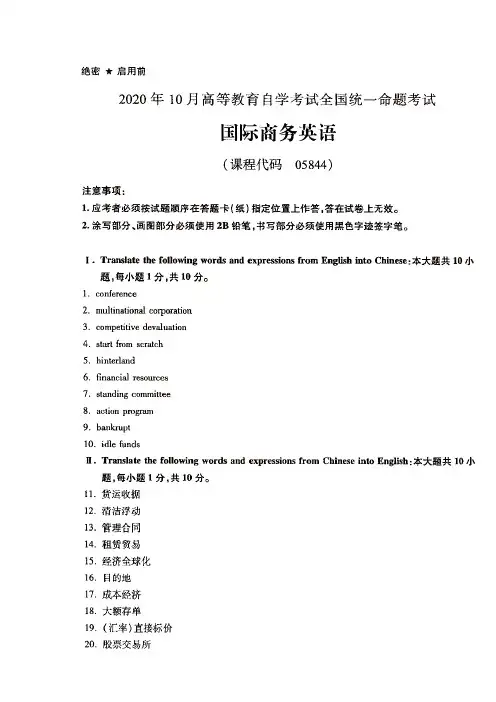
一、What does international business refer to? Please tell the difference between international business and domestic business.1. International business refers to transactions between parties from diffirent countries.There are four major diffrences between international business and domestic business:1)differences in legal system2)differences in currencies3)differences in cutural background4)differences in natural and economic conditionsPlease explain the differences between visible trade and invisible trade. Which is becoming more and more important and accounts for an increasing proportion in international trade?modity trade, i.e exporting and importing goods produced or manufactured in onecountry for consumption or resale in another. This kind of trade is also referred to visible trade.Invisible trade is in the form of transportation, communication, banking, insurance, consulting, information etc. Invisible trade is becoming more and more important and accounts for an increasing proportion in international trade.Can you cite some examples to illustrate cultural differences in international business?3.Cultural differences including language, customs, traditions, religion, value, behavior etc. Please elaborate on the two categoreis of international investment. What is their major difference?4.Foreign direct investments or FDI for short is made for returns through controlling theenterprises or assets invested in in a host country.Portfolio investment refers to purchases of foreign financial assets for a purpose other than controlling.What is licensing? Why do firms sometimes choose it as means of entering a foreign market?5.In licensing, a firm leases the right to use its intellectual property to a firm in another country.Firms choose licensing because they do not want to make cash payments to start business, and can simply receive income in the form of royalty. Besides, they can benefit from locational advanteges of foreign operation without any obligations in ownership or management.What is franchising? How is it different from licensing?6.Under franchising, a fim, called the franchisee, is allowed to operate in the name of another,called the franchiser who provides the former with trademarks, brand name, logos, and operating techniques for royalty.In comparision with the relation between the licenser and the licensee, the franchiser has more control over and provides more support for the franchisee.What is a management contract? Under what conditions is it most applicable?7.Under a management contract, one company offers managerial or other specialized services toanother within a particular period for a flat payment or a percentage of the relevant business volum.When a government forbids foreign ownership in certain industries it considers to be of strategic importance but lacks the expertise for operation, management contracts may be a practical choice enabling a foreign company to operate in the industry without owning the assets..What is an international turnkey project? In what way is its variant BOT different from it?8.For an interantional turnkey project, a firm signs a contract with a foreign purchaser andundertakes all the designing, contracting and facility equiping before handing it over to the latter upon completion.For a BOT project, a firm operate a facility for a period of time after building it up before finally transferring it to a foreign company.Making profit from operating the project for a period is the major difference between BOT and the common turnkey project.Franchise: an arrangement by which a monopoly producer or owner gives another permission for the exclusive right to manufacture or sell the products in certain area.Royalty: money paid to the owner of a copyright fr permission to publish copy right material and to the owner of a patent for permission to use a patented design, usu, at an agreed percentage of the selling price of the product.Patent: a special right to an inventor to be the only person to make and sell, or to authorize others to make and sell a newly-invented machine or process.Non-tariff barries: all forms of man-made obstructions to international trade other than tariffs, including prohibitions and quotas, etc.Portfolio: the entire collection of investments in the form of stocks, bonds, or certificate of deposits for purposes other than controlling.Turnkey project: one in which one of the parties agrees to supply, at the contract price, a complete product ready for use, such as a new home, factory, ship, etc.Budget: an account of probable future income and expenditure during a stated, period, usu, a year used as a guide in making financial arragements.Return: the gain from an investment, either as income or yield or as profit on the sale of the investment.Expertise: expert knowledge or skill, esp. in a particular field; know-howLicensor: a person or company granting a licence1.国际贸易一般指不同国家的当事人进行的交易,它涉及到许多因素,因而比国内贸易要复杂得多。
自考商务英语试题及答案商务英语自考试题及答案一、选择题(每题2分,共20分)1. In international business, what does "FOB" stand for?A. Free on BoardB. Freight on BoardC. Friend of BusinessD. Full of Benefits答案:A. Free on Board2. Which of the following is not a typical form of business negotiation?A. Face-to-faceB. EmailC. TelephoneD. Telepathy答案:D. Telepathy3. The term "B2B" refers to:A. Business to BusinessB. Business to ConsumerC. Business to GovernmentD. Business Travel Bureau答案:A. Business to Business4. What is the primary purpose of a SWOT analysis in business?A. To identify strengths, weaknesses, opportunities, and threatsB. To analyze financial statementsC. To conduct market researchD. To create a business plan答案:A. To identify strengths, weaknesses, opportunities, and threats5. In business English, "PIE" can stand for:A. Product, Investment, ExpenseB. Price, Income, ExpenseC. Product, Income, ExpenseD. Profit, Investment, Expense答案:C. Product, Income, Expense6. The phrase "due diligence" in a business context usually refers to:A. The process of investigating a company before acquiring itB. The process of paying bills on timeC. The process of conducting a financial auditD. The process of performing a market survey答案:A. The process of investigating a company before acquiring it7. Which of the following is a common method of payment ininternational trade?A. Cash on Delivery (COD)B. Letter of Credit (LC)C. BarterD. All of the above答案:D. All of the above8. A "sole proprietorship" is a type of business structure where:A. There is only one owner who is fully responsible for the businessB. The business is owned and operated by a married coupleC. The business is a partnership with two or more individualsD. The business is a corporation with shareholders答案:A. There is only one owner who is fully responsible for the business9. "EBITDA" stands for:A. Earnings Before Interest, Taxes, Depreciation, and AmortizationB. Economic Business Income, Taxes, Depreciation, and AmortizationC. Employee Benefits Including Taxes, Depreciation, and AmortizationD. Equity Before Interest, Taxes, and Depreciation, and Amortization答案:A. Earnings Before Interest, Taxes, Depreciation,and Amortization10. The "4Ps" of marketing refer to:A. Product, Price, Place, PromotionB. People, Process, Physical evidence, PerformanceC. Planning, Positioning, Pricing, ProductD. Product, Price, Placement, Partnership答案:A. Product, Price, Place, Promotion二、填空题(每题2分,共20分)11. The international business term "CIF" stands for_______________________.答案:Cost, Insurance, and Freight12. A(n) _________________ is a document that provides evidence of the terms of a shipment and serves as a contract between the seller and the buyer.答案:Bill of Lading13. In business, "ROI" refers to _________________________.答案:Return on Investment14. The process of systematically gathering and analyzing information about a market is known as _________________.答案:Market Research15. A "joint venture" is a business arrangement in which_________________________.答案:Two or more businesses agree to pool their resources for a specific project16. The term "venture capital" refers to funds that are available for investment in new or struggling businesses, with the expectation of _________________________.答案:High returns in the form of equity or debt17. A "trade deficit" occurs when a country's_________________________ is greater than its exports.答案:Imports18. "GDP" stands for _________________________.答案:Gross Domestic Product19. In business, "DPO" can stand for_________________________.答案:Days Payable Outstanding20. A "franchise" is a type of business where the owner receives the right to operate a business that is part of a larger network, in exchange for a fee and the agreement to follow certain _________________________.答案:Operating procedures and standards。
Lesson 1International Business1. What does international business refer to? Please tell the difference between international business anddomestic business.A: International business refers to transaction between parties from different countries. Sometimes business across the borders of different customs areas of the same country is also regarded as import and export. Some major differences between international business and domestic business is following: (1) Differences in legal systems (2) Differences in currencies (3) Differences in cultural background (4) Different in natural and economic conditions 2. Please explain the differences between visible trade and invisible trade. Which is becoming more andmore important and accounts for an increasing proportion in international trade?A: Visible trade is the form of commodity trade. The form of transportation, communication, banking, insurance, consulting, consulting, information information information etc. etc. etc. is is is called called called invisible invisible invisible trade trade trade or or or service service service industries. industries. industries. The The The later later later is is is become become become more more more and and and more more important. 3. Can you cite some examples to illustrate cultural differences in international business?A: Cultural differences including language, customs, traditions, religion, value, behavior etc.4. Please elaborate on the two categories of international investment. What is their major difference? A: FDI (Foreign direct investment) is made for returns through controlling the enterprises or assets invested in in a host host country. country. Portfolio investment refers to to purchases purchases purchases of of of foreign foreign financial assets assets for for for a a a purpose purpose other than controlling. Such financial assets may be stocks, bonds or certificates of deposit. 5. What is licensing? Why do firms sometimes choose it as a means of entering a foreign market?A: In licensing, a firm leases the right to use its intellectual property to a firm in in another country. They choose another country. They choose licensing because they do not have to make cash payments to stat business, and can simply receive income in the form of royalty. Besides, they can benefit from locational advantages of foreign operation without any obligations in ownership or management. The use of licensing is particularly encouraged by high customs duty and non-tariff barriers on the part of the host country. 6. What is franchising? How is it different from licensing?A: Under franchising, franchisee is allowed to operate in the name of another, franchiser who provides the former with trademarks, brand names, logos and operating techniques for royalty. In comparison with the relation between the licenser and the licensee, the franchiser has more control over and provides more support for the franchisee. 7. What is a management contract? Under what conditions is it most applicable?A: Under a management contract, one company offers managerial or other specialized services to another within a particular period for a flat payment or a percentage of the relevant business volume. When a government forbids foreign foreign ownership ownership ownership in in in certain certain certain industries industries industries it it it considers considers considers to to to be be be of of of strategic strategic strategic importance importance importance but but but lacks lacks lacks the the the expertise expertise expertise for for operation, management contracts maybe a practical choice enabling a foreign company to operate in the industry without owning the assets. 8. What is an international turnkey project? In what way is its variant BOT different from it? A: For an international turnkey project, a firm signs a contract with a foreign purchaser and undertakes all the designing, designing, contracting contracting contracting and and and facility facility facility equipping equipping equipping before before before handing handing handing it it it over over over to to to the the the latter latter latter upon upon upon completion. completion. completion. For For For a a a BOT BOT project, a firm operates a facility for a period of time after building it up before finally transferring it to a foreign company. Making profit profit from from from operating operating operating the the the project project project for for for a period a period is the major major difference difference difference between between between BOT BOT BOT and and and the the common turnkey project Lesson 2 Income Level and the W o rld Market orld Market 1. Explain the concepts of GNP and GDP respectively and point out their major difference. Can we use them interchangeably? A: GNP (Gross national Product) refers to the market value of goods and services produced by the property and labor labor owned owned owned by by by the the the residents residents residents of of of an an an economy. GDP economy. GDP (Gross (Gross Domestic Domestic Domestic Product) Product) Product) measures the measures the market market value value value of of of all all goods and services produced within the geographic area of an economy. The difference between them is that GNP focuses on ownership of the factors of production while GDP concentrates on the place where production takes place. The difference between GNP and GDP can be ignored since it very small in most cases. Therefore, we can use them interchangeably. 2. In what different ways are GDP and per capita income significant in assessing the potential of a particular market? A: Total Total GDP GDP GDP indicates indicates indicates the the the overall overall overall size size size of of of an an an economy, economy, economy, which which which is is is important important important in in in market market market assessment assessment assessment for for for durable durable equipment or bulk goods (grain, steel or cement). Per capita GDP reveals the average income level of consumers, which is important when marketing consumer durables. 3. What are meant by high income, middle income, and low-income countries according to the W orld Bank? Cite some examples for each group. A: High-income countries: those enjoying annual per capita income of $9386 and above. In this group comprise three types of countries; most members of OECD, rich oil producing countries of the Middle East, small-industrialized countries or regions. Middle-income countries: those with annual per capita income below $9386 but above $765. Included in this category category is is is most most most East East East European European European countries countries countries and and and most most most members members members of of of the the the Commonwealth Commonwealth Commonwealth of of of Independent Independent Independent States, States, States, six six OECD members, quite a number of Latin American countries and some comparatively developed countries in Asia, South Africa and oil-producing countries in African. Low-income countries: those that have per capita incomes of only $765 or even less. Most African countries, some Asian countries and a few Latin American countries are included in this group. 4. 4. Why Why Why are are are high-income high-income high-income countries countries countries important important important to to to trade trade trade and and and investment? investment? investment? Should Should Should we we we neglect neglect neglect low-income low-income countries in international business? A: High-income High-income countries countries countries often often often have have good good infrastructure, infrastructure, infrastructure, high high high purchasing purchasing purchasing power, power, power, and and and advanced advanced advanced technology, technology, efficient management and favorable environment for trade and investment. They offer prime markets for expensive consumer goods and are both attractive sources and destinations of investment. In international trade the low-income countries should not be neglected, because they constitute markets for lower-priced staple goods, provide cheap labor and are often rich in resources. Once tapped, the business potential of these countries will one day become real business opportunities. 5.W as China a low-income country a few years ago? How about now?A: China with a per capita income of over $1100 is a middle-income country though it was a low-income country just a few years ago. 6.What does the term“Triad ” refers to? What is meant by Quad? A: The term Triad refers to the three richest regions of the world; the United States, the European Union and Japan that offer the most important business opportunities. The scope of Triad to include Canada and name the broadened grouping Quad. 7. How much do you know about OECD? Please make a brief account.A: OECD OECD means means means Organization Organization Organization for for for Economic Economic Economic Cooperation Cooperation Cooperation and and and Development. Development. Development. The The The organization organization organization is is is included included included 29 29 members, 23 of them are high-income countries and 6 are middle-income countries. The headquarters is in Paris. 8. What is the best policy for China to develop business opportunities?A: So far as China is concerned, other markets we should pay particular attention to are those around us: the Four Tigers, the ASEAN countries, Russia, India and a bit farther away Australia. These countries or regions either have rich consumers and offer good business opportunities or are developing fast with very promising market potential. And their geographical proximity to China is a great advantage for us in developing business relations with them. Lesson 3Regional Economic Integration1. What is a free trade area? Make a brief account of the most notable free trade area in the world. A: Free trade area is the loosest form in the regional economic integration. Members in this form removes barriers to the flow of goods and services among themselves while each member still adopts its own policy as regards to trade with outsiders. The most notable one is the North American Free Trade Agreement (NAFTA), the largest free market formed by the United States, Canada and Mexico in 1991 with over 360 million consumers and total GDP of more than 6 trillion US dollars. 2. In what way is a customs union different from a free trade area?A: The Customs Union goes a step further by adopting the same trade policy for all the members toward countries outside their organization in addition to abolishing trade barriers among themselves. Imports from other countries are subject to the same tariff. 3. What are the characteristics of a common market? Which organization remained a common marketfor some years in the past?A: The common market is further up the scale of regional economic integration. Besides free movement of goods and and services services services and and and adoption adoption adoption of of of common common common external external external trade trade trade policy, policy, policy, factors factors factors of of of production production production such such such as as as labor, labor, labor, capital capital capital and and technology are free to move among members so that they can be utilized in a more efficient and productive way. In the past, the European Community remained a common market for some years.4. How much do you know about economic an economic union? union? Can members of economic an economic union union keep all oftheir national sovereignty?A: The economic union is the highest form of economic integration, which is characterized by integration of the domestic domestic policies policies policies of of of its its its members members members in in in respect respect respect of of of economy, economy, economy, finance finance finance etc. etc. etc. in in in addition addition addition to to to absence absence absence of of of trade trade trade barriers, barriers, practice of common external policy and free production factor mobility. The members of an Economic Union are required required not not not only to only to harmonize harmonize their their their taxation, taxation, taxation, government government government expenditure, expenditure, expenditure, industry policies, industry policies, etc., etc., but but but also also also use use use the the same currency. The member countries of an economic union are required to surrender some of their national sovereignty, which is eroding the tradition of the world political system based on the autonomy and supreme power of sovereign states. 5. Make a brief account of the origin and development of the EU. A: The first community, the European Coal and Steel Community (ECSC) was established in 1952, which set the stage for more ambitious integration efforts. The signing of the monumental Treaty of Rome in 1957 marks the establishment of the European Economic Community with the aim of gradually realizing the free movement of goods, services, labor and capital as well as the harmonization of economic policies of the member countries.Ten years later in 1967, the European Community was formed by merging EEC, ECSC and European Atomic Energy Community (EURA TOM). 1992 it became a true common market as envisaged by the Single European Act . Then on January 1, 1994 the European Union (EU) came into being on the strength of the Maastricht Treaty . From the beginning of 1999 most of the members began to use the common European currency for accounting and settlement and in 2002, euro banknotes and coins were put into circulation. 6. What is the most powerful institution of the EU? What is the executive body of the EU? How does itoperate?A: The most powerful institution of the EU is the Council of Ministers. Its executive body is the European Commission composed of 20 commissioners overseeing 23 departments in charge of different affairs. Decisions Decisions of of of the the the council council council are are are made made made by by by votes votes votes allocated allocated allocated to to to member member member countries countries countries on on on the the the basis basis basis of of of their their their size. size. size. Different Different ministers attend the council meeting depending on the matters discussed. The council even has the power to pass legislation.7. Explain briefly the five layer organizational structure of Asia-Pacific Economic Cooperation.A: a. the Informal Meeting of Economic leaders b. Dual-Ministerial Meeting c. Ministers Responsible for Trade d. The Senior Officials Meeting (SOM) e. Subordinate committees under SOM: Committee of Trade and Investment, Economic Committee, Economic and Technical Cooperation Sub-committee of SOM and Budget Management Committee. 8. What are the tenet and objectives of APEC? What do its two wheels mean?A: The tenet and objectives of APEC are inter-dependence, mutual benefits, adhering to an open and multilateral trading system and reduction of regional trade barriers. Its Its two two two wheels wheels wheels mean mean mean trade trade trade and and and investment investment investment liberation liberation liberation and and and facilitation facilitation facilitation (TILF) (TILF) (TILF) and and and economic economic economic and and and technical technical cooperation (ECOTECH).MNEs are generally enormous in size and and pricing. pricing. pricing. They They They are are are also also also more more more able able able to to to take take take advantage advantage advantage of of of changes changes changes in in in the the the international international international economic economic economic environment. environment. Such multi-nationality also enables MNEs to engage in worldwide integrated production and marketing. 8. What is the relationship between MNEs and their host countries?A: MNCs are under the legal jurisdiction of their host governments that can impose various rules, regulations, and laws on the MNCs to the extent of nationalizing all their assets. 9. What are the four types of multinational enterprises? Describe each of them briefly.A: The four types of multinational enterprises is that: d. Multi-domestic corporation: it is a group of relatively independent subsidiaries. The parent company delegates sufficient power to each subsidiary to manage the production and marketing in the host country for the needs of local customers.e. Global corporation: it it operates operates operates and and and views views views the the the world world world market market market as as as an an an integrated integrated integrated whole. whole. whole. Power Power Power and and responsibility are concentrated at the headquarters that manages production and marketing to achieve the economies of scale as much as possible.f. Transnational Corporation: The The activities activities activities and and and resources resources resources of of of the the the transnational transnational transnational corporation corporation corporation are are are highly highly neither neither centralized centralized as as the the the second second second type type type nor nor nor decentralized decentralized decentralized as as as the the the first first first type type type but but but are are are integrated integrated in in an an interdependent network of affiliates.g. W orld Company: t heir national identities are blurred to a large extent.their national identities are blurred to a large extent.10. Are there may world companies at present? Imagine their future role in complete globalization.A: Now it is very few. When such companies become dominating, the possibility of conflicts among sovereign states may be greatly reduced. Possibly they will be instrumental to the realization of complete globalization.。
国际商务英语课后答案1、I'm sorry I cannot see you immediately. But if you wait, I'll see you_____. [单选题] *A. for a momentB. in a moment(正确答案)C. for the momentD. at the moment2、80.Thousands of ________ from other countries visit the village every year. [单选题] * A.robotsB.postcardsC.tourists(正确答案)D.bridges3、It took a long time to _______ Tom to go shopping with me. [单选题] *A. speakB. tellC. persuade(正确答案)D. talk4、38.—Do you have ________else to say for your mistake?—________but sorry. [单选题] * A.anything; SomethingB.something; EverythingC.anything; Nothing(正确答案)D.something; Anything5、We need a _______ when we travel around a new place. [单选题] *A. guide(正确答案)B. touristC. painterD. teacher6、Experts are making an investigation on the spot. They want to find a way to()the tower. [单选题] *A. Restore(正确答案)B. resumeC. recoverD. reunite7、Something must be wrong with the girl’s _______. She can’t hear clearly. [单选题] *A. ears(正确答案)B. noseC. armsD. eyes8、32.There are about __________ women doctors in this hospital. [单选题] *A.two hundred ofB.two hundreds ofC.two hundredsD.two hundred (正确答案)9、--How is your friend coming?--I’m not sure. He _______ drive here. [单选题] *A. may(正确答案)B. canC. mustD. will10、—Can you play the violin at the art festival?—No, I ______. But I am good at playing the drums.()[单选题] *A. canB. can’t(正确答案)C. doD. don’t11、A?pen _______ writing. [单选题] *A. is used toB. used toC. is used for(正确答案)D. used for12、Tom’s mother will let him _______ traveling if he comes back?in five days. [单选题] *A. to goB. goesC. wentD. go(正确答案)13、There are still some wild tigers alive. [单选题] *A. 聪明的B. 凶恶的C. 野生的(正确答案)D. 珍贵的14、What’s the price and what sort of _______ do you offer? [单选题] *A. advantageB. accountC. displayD. discount(正确答案)15、( ) She keeps on learning English all the time. So far, she______three books of New Concept English. [单选题] *A. has learned(正确答案)B. have learnedC. had learnedD. learn16、They all choose me ______ our class monitor.()[单选题] *A. as(正确答案)B. inC. withD. on17、_________ we don't stop climate change, many animals and plants in the world will be gone. [单选题] *B.WhileC.If(正确答案)D.Until18、During the Mid-Autumn Festival, family members often gather together _________ ameal, admire the moon and enjoy moon cakes. [单选题] *A. shareB. to share(正确答案)C. having sharedD. shared19、32.Mr. Black is ______ now, so he wants to go to a movie with his son. [单选题] *A.busyB.free(正确答案)C.healthyD.right20、The scenery is so beautiful. Let’s _______. [单选题] *A. take photos(正确答案)B. take mapsD. take exams21、John suggest _____ anything about it until they found out more facts. [单选题] *A not to sayB. not sayC to say notD not saying(正确答案)22、19.Students will have computers on their desks ________ . [单选题] *A.in the future(正确答案)B.on the futureC.at the momentD.in the past23、Be _______ when you are driving. [单选题] *A. afraidB. careful(正确答案)C. clearD. clean24、I've never been to Africa, but that is the place(). [单选题] *A. where I most want to visitB. in which I most want to visitC. I most want to visit(正确答案)D. that I want to visit it most25、She found her wallet()she lost it. [单选题] *A. where(正确答案)B. whenC. in whichD.that26、—What can I do for you? —I ______ a pair of new shoes.()[单选题] *A. likeB. would lookC. would like(正确答案)D. take27、13.—Will you come to my party?—I am not ________ . [单选题] * A.mindB.sure(正确答案)C.happyD.Sorry28、Chinese people spend _____ money on travelling today as they did ten years ago. [单选题] *A. more than twiceB. as twice muchC. twice as much(正确答案)D. twice more than29、If people _____ overanxious about remembering something, they will forget it. [单选题] *A. will beB. would beC. wereD. are(正确答案)30、The story has _______ a lot of students in our class. [单选题] *A. attracted(正确答案)B. attackedC. appearedD. argued。
自考国际商务英语课后题一、What does international business refer to? Please tell thedifference between international business and domestic business.1. International business refers to transactions between partiesfrom diffirent countries.There are four major diffrences between international business and domestic business:1) differences in legal system2) differences in currencies3) differences in cutural background4) differences in natural and economic conditionsPlease explain the differences between visible trade and invisible trade. Which is becoming more and more important and accounts for an increasing proportion in international trade?2. Commodity trade, i.e exporting and importing goods produced or manufactured in onecountry for consumption or resale in another. This kind of trade is also referred to visible trade. Invisible trade is in the form of transportation, communication, banking, insurance, consulting, information etc. Invisible trade is becoming more and more important and accounts for an increasing proportion in international trade.Can you cite some examples to illustrate cultural differences in international business?3. Cultural differences including language, customs, traditions, religion, value, behavior etc. Please elaborate on the two categoreis of international investment. What is their major difference?4. Foreign direct investments or FDI for short is made for returns through controlling theenterprises or assets invested in in a host country.Portfolio investment refers to purchases of foreign financial assets for a purpose other than controlling.What is licensing? Why do firms sometimes choose it as means of entering a foreign market?5. In licensing, a firm leases the right to use its intellectual property to a firm in another country.Firms choose licensing because they do not want to make cash payments to start business, and can simply receive income in the form of royalty. Besides, they can benefit from locational advanteges of foreign operation without any obligations in ownership or management. What is franchising? How is it different from licensing?6. Under franchising, a fim, called the franchisee, is allowed to operate in the name of another,called the franchiser who provides the former with trademarks, brand name, logos, and operating techniques for royalty.In comparision with the relation between the licenser and the licensee, thefranchiser has more control over and provides more support for the franchisee.What is a management contract? Under what conditions is it most applicable?7. Under a management contract, one company offers managerial orother specialized services toanother within a particular period for a flat payment or apercentage of the relevant business volum.When a government forbids foreign ownership in certain industries it considers to be of strategic importance but lacks the expertise for operation, management contracts may be a practical choice enabling a foreign company to operate in the industry without owning the assets..What is an international turnkey project? In what way is its variant BOT different from it?8. For an interantional turnkey project, a firm signs a contractwith a foreign purchaser andundertakes all the designing, contracting and facility equipingbefore handing it over to the latter upon completion.For a BOT project, a firm operate a facility for a period of timeafter building it up before finally transferring it to a foreign company.Making profit from operating the project for a period is the major difference between BOT and the common turnkey project. Franchise: anarrangement by which a monopoly producer or owner gives another permission for the exclusive right to manufacture or sell the products in certain area.Royalty: money paid to the owner of a copyright fr permission to publish copy right material and to the owner of a patent for permission to use a patented design, usu, at an agreed percentage of the selling price of the product.Patent: a special right to an inventor to be the only person to make and sell, or to authorize others to make and sell a newly-invented machine or process.Non-tariff barries: all forms of man-made obstructions to international trade other than tariffs, including prohibitions and quotas, etc.Portfolio: the entire collection of investments in the form of stocks, bonds, or certificate of deposits for purposes other than controlling.Turnkey project: one in which one of the parties agrees to supply, at the contract price, a complete product ready for use, such as a new home, factory, ship, etc.Budget: an account of probable future income and expenditure during a stated, period, usu, a year used as a guide in making financial arragements.Return: the gain from an investment, either as income or yield or as profit on thesale of the investment.Expertise: expert knowledge or skill, esp. in a particular field; know-howLicensor: a person or company granting a licence 1.国际贸易一般指不同国家的当事人进行的交易,它涉及到许多因素,因而比国内贸易要复杂得多。